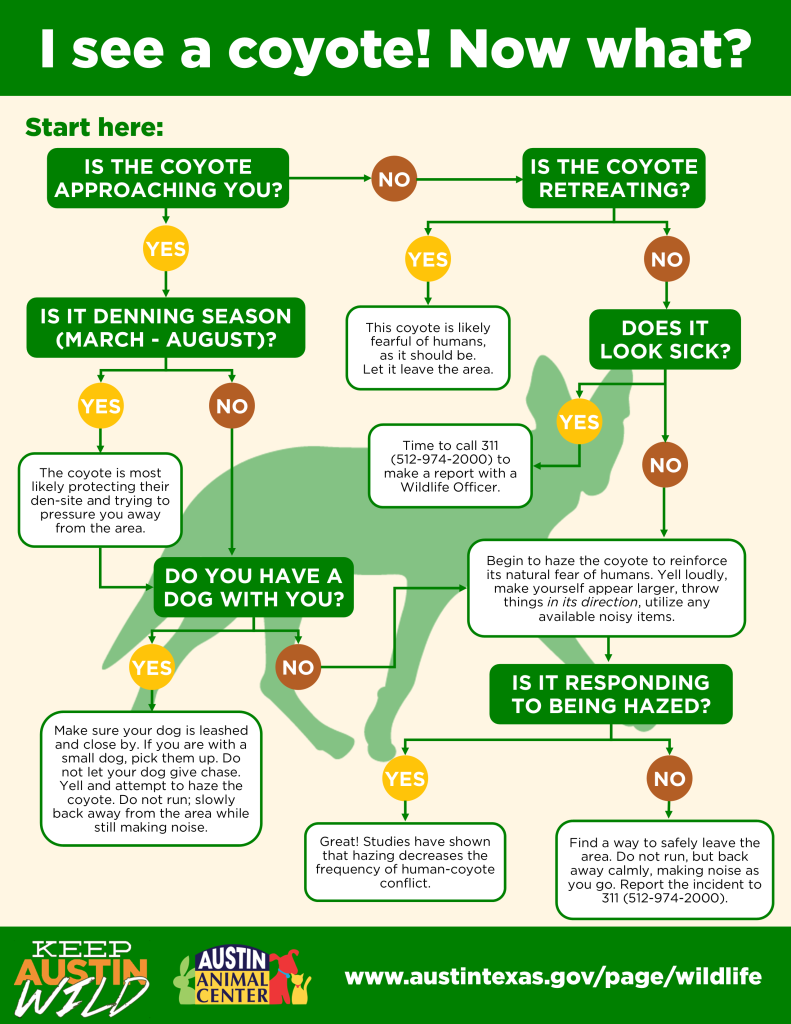As Austin continues to grow, there are increased interactions with all kinds of wildlife – including coyotes. Coyotes are found all over the United States and are sighted in most major cities, including Austin and Travis County.
Coyote Management in the City of Austin
In November 2014, the City Council approved a Coyote Management Policy through a resolution for the City of Austin. The policy balances public safety concerns by providing criteria for determining public safety threats and humane treatment for all animals.
If you would like free city brochures about coyotes or a free presentation for your school, HOA, group of neighbors, or any other group, please contact our Wildlife Officer at 512-978-0514.
Information on Coyotes in Central Texas
Coyotes tend not to be picky eaters, so when it comes to Austin, they will take advantage of any food source available. Coyotes are known for hunting rodents, rabbits, fawns, snakes, pet food left outdoors, and any fruit and nuts that have fallen from your trees. They are also known for preying upon small animals, like unsupervised small dogs or outside cats. (Read What to Do Around Your Home and Neighborhood for tips on keeping smell pets and other animals safe.)

Even though coyotes are most active at dawn and dusk, they are sighted during the daytime in neighborhoods and greenbelts. They use different vocalizations to talk to one another and can be heard during the day, but mostly at night. Coyotes weigh from 25-40 pounds and are often mistaken for being larger due to their fur coat.
Coyotes are naturally afraid of humans, but at times they can become comfortable seeing people. There are a lot of food sources in neighborhoods, so when they are sighted and not given a reason to be afraid of people, it can cause coyotes to be sighted more throughout the day and become comfortable with human presence.
Help Keep Austin Wild, but safe for the community by reducing and removing possible food and water sources, keeping up with properties to reduce places to shelter and hazing coyotes when necessary. Hazing helps keep coyotes afraid of people and making them uncomfortable.
Coyote Seasons
.png)
What to Do Around Your Home and Neighborhood
- Keep wildlife wild – don’t feed them!
- Do not leave pet food outside. Pick up any leftover food once your pet is done eating.
- Keep small pets inside if possible and monitor them when outside
- Provide secure shelters for poultry or other animals living outside
- Always follow leash laws and walk dogs on leashes 6’ or less in length (retractable leashes are not recommended)
- Check your property for and remove potential sources of food and water
- Clean up bird seed on the ground
- Tightly cover and secure garbage cans and compost bins
- Clean up under fruit and nut trees
- Trim brush and shrubbery near ground level
- Make sure fences are secure and close off crawl spaces under porches, decks and sheds
- Install motion activated sprinklers or outdoor lighting around your property
Tips for humanely deterring wildlife
Coexistence is not blind tolerance!
How to scare a coyote away to minimize future interactions
We want to share space, but NOT time with coyotes. Sometimes coyotes need to be reminded that being around residents is not a positive thing. Hazing is a process that helps reshape coyote behavior and encourages coyotes to avoid contact with people and pets. It strengthens coyotes need to be afraid of people. The more a coyote is hazed using several tools and techniques by a resident, the more effective it will be for the entire community. Hazing should be exaggerated, confident and expected. It is a common technique used in cities around the country.
- Make eye contact, yell, and wave your arms. You want the coyote to know the behavior is directed at it. Waving your arms will make you seem bigger.
- Use noisemakers such as whistles, air horns, a “shaker” can full of small rocks (or something similar), or bang something like pots and pans together.
- If the coyote does not leave immediately, throw non-edible objects near it. You can use something like small rocks, sticks or tennis balls. Remember, the goal is not to hurt the coyote, you’re trying to get it to leave and associate humans with unpredictable, “scary” behavior.
- Spray the coyote with a water hose, water guns or spray bottles. You can also use a mixture of water and vinegar, pepper spray or bear repellant.
- If the coyote does not leave after escalating hazing efforts, maintain eye contact and back away slowly. Notify 311 immediately.
Please do not haze if a coyote is sick or injured, cornered (give the coyote space to leave the area), with pups or pups are around, or sighted in the middle of the night when most residents are not awake. Report to 3-1-1 (512-974-2000) if you have questions, concerns, or see a sick or injured animal.


